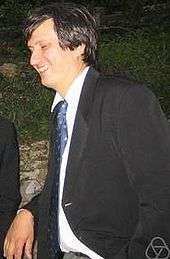Maxim Kontsevich
| Maxim Kontsevich | |
|---|---|
 | |
| Born |
25 August 1964 Khimki, Russian SFSR, Soviet Union |
| Residence | Miami, United States |
| Citizenship |
Russia France |
| Nationality | Russian |
| Fields | Mathematics |
| Institutions |
Institut des Hautes Études Scientifiques University of Miami |
| Alma mater |
University of Bonn Moscow State University |
| Doctoral advisor | Don Bernard Zagier |
| Doctoral students | Dmitri Panov |
| Notable awards |
EMS Prize (1992) Otto Hahn Medal (1992) Henri Poincaré Prize (1997) Fields Medal (1998) Crafoord Prize (2008) Shaw Prize (2012) Fundamental Physics Prize (2012) Breakthrough Prize in Mathematics (2014) National Academy of Sciences (Foreign Associate) (2015) |
Maxim Lvovich Kontsevich (Russian: Макси́м Льво́вич Конце́вич;![]() [mɐˈksʲim lʲˈvovʲit͡ɕ konˈt͡sɛvʲit͡ɕ] ; born 25 August 1964) is a Russian and French[1] mathematician. He holds both Russian and French citizenship. He is a professor at the Institut des Hautes Études Scientifiques and a distinguished professor at the University of Miami. He received the Henri Poincaré Prize in 1997, the Fields Medal in 1998, the Crafoord Prize in 2008, the Shaw Prize and Fundamental Physics Prize in 2012, and the Breakthrough Prize in Mathematics in 2014.[2]
[mɐˈksʲim lʲˈvovʲit͡ɕ konˈt͡sɛvʲit͡ɕ] ; born 25 August 1964) is a Russian and French[1] mathematician. He holds both Russian and French citizenship. He is a professor at the Institut des Hautes Études Scientifiques and a distinguished professor at the University of Miami. He received the Henri Poincaré Prize in 1997, the Fields Medal in 1998, the Crafoord Prize in 2008, the Shaw Prize and Fundamental Physics Prize in 2012, and the Breakthrough Prize in Mathematics in 2014.[2]
Biography
He was born into the family of Lev Rafailovich Kontsevich, Soviet orientalist and author of the Kontsevich system. After ranking second in the All-Union Mathematics Olympiads, he attended Moscow State University but left without a degree in 1985 to become a researcher at the Institute for Problems of Information Transmission in Moscow.[3] In 1992 he received his Ph.D. at the University of Bonn under Don Bernard Zagier. His thesis outlines a proof of a conjecture by Edward Witten that two quantum gravitational models are equivalent.
His work concentrates on geometric aspects of mathematical physics, most notably on knot theory, quantization, and mirror symmetry. One of his results is a formal deformation quantization that holds for any Poisson manifold. He also introduced knot invariants defined by complicated integrals analogous to Feynman integrals. In topological field theory, he introduced the moduli space of stable maps, which may be considered a mathematically rigorous formulation of the Feynman integral for topological string theory.
Honors and awards
In 1998, he won the Fields Medal for his "contributions to four problems of Geometry". In July 2012, he was an inaugural awardee of the Fundamental Physics Prize, the creation of physicist and internet entrepreneur, Yuri Milner.[4]
See also
- Kontsevich integral
- Homological mirror symmetry
- Motivic integration
- Kontsevich quantization formula
- Ring of periods
Notes
- ↑ Kontsevich received French citizenship in 1999 and remains a dual citizen of both the France and his native Russia.
- ↑ Chang, Kenneth (23 June 2014). "The Multimillion-Dollar Minds of 5 Mathematical Masters". The New York Times.
- ↑ http://www.berkeley.edu/news/berkeleyan/1994/1012/math.html A Very Pleasurable Universe
- ↑ New annual US$3 million Fundamental Physics Prize recognizes transformative advances in the field, FPP, accessed 1 August 2012
References
- Fields Medal citation at the website of the 2002 International Congress of Mathematicians held in Beijing.
- Taubes, Clifford Henry (1998) "The work of Maxim Kontsevich". In Proceedings of the International Congress of Mathematicians, Vol. I (Berlin, 1998). Doc. Math., Extra Vol. I, 119–126.
External links
- O'Connor, John J.; Robertson, Edmund F., "Maxim Kontsevich", MacTutor History of Mathematics archive, University of St Andrews.
- Maxim Kontsevich at the Mathematics Genealogy Project
- AMS Profile of Maxim Kontsevich
- Official Homepage of Maxim Kontsevich
- Stankova, Zvezdelina. "Pebbling a Chessboard". YouTube: Brady Haran. Retrieved 19 December 2013.